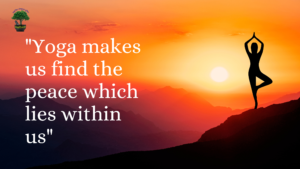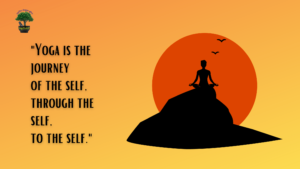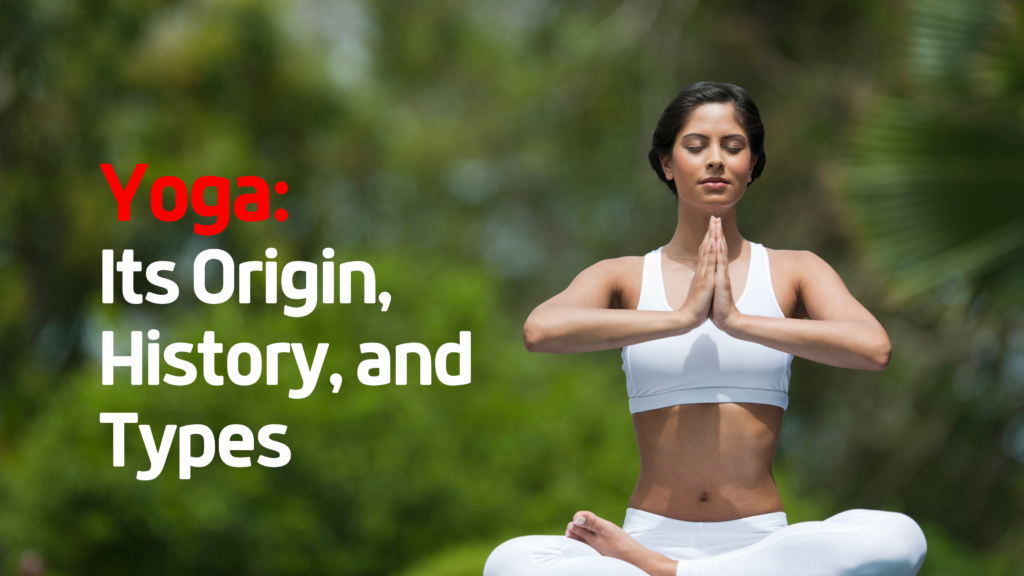Yoga: Its Origin, History, and Types
Yoga is a physical, mental, and spiritual discipline that originated in ancient India. It involves various physical postures and movements, as well as breathing techniques and meditation practices, that are designed to improve flexibility, strength, and relaxation. Yoga can be
practiced by people of all ages and fitness levels and is often used as a form of exercise and stress relief. Some people also use yoga as a way to improve their overall health and well- being. There are many different styles of yoga, each with its own unique focus and techniques, so you can choose the one that best meets your needs and goals. Some common styles include Hatha yoga, Vinyasa yoga, and Bikram yoga. If you want to practise all these Yoga Styles you can go to the best ayurvedic wellness centers where you’ll get the best Yoga trainers to whom you can assist and learn different forms of yoga. It is important to find a qualified and experienced instructor when starting a yoga practice, as proper technique and alignment are essential for maximizing the benefits and avoiding injury.

Origin and History Of Yoga
The origins of yoga can be traced back to ancient India, where it was developed as a spiritual practice and philosophical system. Yoga has a long and rich history, with references to its teachings and practices dating back to the Vedic period (1500-500 BCE). The word “yoga” itself is derived from the Sanskrit root “yuj,” which means “to yoke” or “to unite.” This refers to the idea that the practice of yoga helps to unite the individual self with the universal consciousness or divine.
Over the centuries, yoga has evolved and been adapted in various ways, but its core principles have remained largely unchanged. Yoga has been practiced in various forms in Hinduism, Buddhism, and Jainism, and it has also influenced other spiritual traditions around the world. In modern times, yoga has become popular as a form of exercise and stress management and is practiced by people of all ages and backgrounds around the world.
Vedic Chikitsa
Vedic Chikitsa, also known as Ayurveda, is a traditional system of medicine that originated in ancient India. It is based on the belief that health and wellness depend on a balance between the mind, body, and spirit. The Vedas, ancient Indian scriptures, are considered the foundation of Ayurveda and contain knowledge about the principles of health and disease, as well as the various therapeutic methods used to maintain health and treat illness. Ayurveda is a holistic approach to health that emphasizes the use of natural remedies, such as herbs, nutrition, and lifestyle changes, to prevent and treat disease. In Ayurveda, each individual is believed to have a unique constitution, or dosha, which is made up of the elements of air, fire, water, and earth. Ayurvedic treatment aims to restore balance to the doshas and to the various systems of the body, including the digestive, respiratory, circulatory, and nervous systems.
Ayurveda is a popular form of alternative medicine and is practiced in many parts of the world, including India, where it is an integral part of the healthcare system. It is also gaining popularity in the West as a complementary or integrative approach to healthcare.
Types Of Yoga
There are many different types or styles of yoga, each with its own unique focus and techniques. Some common styles of yoga include:

Therapeutic Yoga:
Therapeutic yoga can be used to address a wide range of health concerns, including stress, anxiety, depression, chronic pain, insomnia, and physical injuries. It can also be helpful for people undergoing medical treatment or recovery, such as cancer patients or those with chronic conditions like fibromyalgia or multiple sclerosis.
Therapeutic yoga is typically taught by a trained yoga therapist in the holistic wellness center, who will work with the individual to develop a personalized practice that meets their specific needs and goals. The practice may include a variety of yoga poses (asanas), breathing techniques (pranayama), and relaxation techniques, as well as meditation and mindfulness practices.
Aqua Yoga:
Aqua yoga, also known as water yoga or aquatic yoga, is a type of yoga that is performed in water. It is typically done in a pool, and may be practiced in shallow or deep water. Aqua yoga combines elements of traditional yoga with exercises and movements that are modified for the water environment.
Aqua yoga can be an enjoyable and effective way to practice yoga, especially for people who may have difficulty with land-based yoga due to physical limitations or injuries. The buoyancy and resistance of the water can help support the body and reduce strain on the joints, making it easier to perform certain yoga poses.
Hatha Yoga:
Hatha yoga is a traditional form of yoga that originated in India. The term “hatha” comes from the Sanskrit words “ha,” meaning “sun,” and “tha,” meaning “moon.” This refers to the balance of opposing forces within the body, such as hot and cold, or positive and negative.
Hatha yoga is characterized by the practice of physical postures (asanas) and breathing techniques (pranayama). It is often described as a “gentle” form of yoga, as it emphasizes proper alignment and the use of props, such as blankets, blocks, and straps, to assist with poses.
The goal of Hatha yoga is to bring balance and harmony to the body and mind, and to prepare the body for meditation. It is believed to help improve flexibility, strength, and relaxation, and to reduce stress and anxiety.
Vinyasa Yoga:
Vinyasa yoga is a style of yoga that emphasizes the connection between movement and breath. It is often referred to as “flow” yoga, as the poses are typically linked together in a smooth, continuous flow.
Vinyasa yoga can be an energizing and challenging practice, as it involves continuous movement and the use of core strength to support the body in various poses. It is thought to improve flexibility, balance, and coordination. It also helps to reduce stress and promote relaxation.
Bikram Yoga:
Bikram yoga is a type of hot yoga that was developed by Bikram Choudhury in the 1970s. It involves the practice of a specific set of 26 postures (asanas) and two breathing techniques (pranayama) in a heated room. The temperature of the room is typically set to around 105 degrees Fahrenheit (40.5 degrees Celsius) with a humidity of 40%.
Bikram yoga is designed to promote flexibility, strength, and balance, and to improve cardiovascular endurance and digestion. It is also believed to help reduce stress and tension, and to improve mental clarity and focus.
Iyengar Yoga:
Iyengar yoga is a form of yoga that was developed by B.K.S. Iyengar, a renowned yoga teacher from India. It emphasizes proper alignment and the use of props, such as blankets, blocks, straps, and chairs, to assist with the performance of poses (asanas).
The goal of Iyengar yoga is to improve flexibility, strength, and balance, and to promote relaxation and stress reduction. It is a highly therapeutic form of yoga that can be modified to meet the needs and abilities of each individual.
Restorative Yoga:
Restorative yoga is a gentle and relaxing form of yoga that is designed to calm the nervous system and promote relaxation and healing. It involves the use of props, such as blankets, blocks, and bolsters, to support the body in a variety of relaxation poses (asanas).
In restorative yoga class in the Best Yoga Center, students typically hold poses for several minutes at a time, allowing the muscles to relax and the body to fully let go. The class may also include pranayama (breathing techniques) and meditation to further promote relaxation and stress reduction.
Yin Yoga:
Yin yoga is a slow-paced style of yoga that involves holding poses (asanas) for extended periods of time, typically 3-5 minutes or longer. It is a more meditative and inward-focused practice, as the poses are held passively, rather than actively.
Yin yoga targets the connective tissues in the body, such as the ligaments, tendons, and fascia, which tend to be less flexible than the muscles. It is believed to improve flexibility, reduce stress and tension, and improve the flow of energy (qi) in the body.
Kundalini Yoga:
Kundalini yoga is a spiritual and physical practice that involves the cultivation of energy (kundalini) through the practice of specific postures (asanas), breathing techniques (pranayama), and meditation. It is believed to awaken the energy at the base of the spine and to move it up through the chakras (energy centers) to the crown of the head.
Kundalini yoga is a dynamic and energetic practice that may include rapid movement, chanting, and the use of hand gestures (mudras) and you can practice this in most of the best wellness centers. It is believed to improve physical and mental strength, and promote spiritual growth and self-awareness.
Power Yoga:
Power yoga is a style of yoga that emphasizes strength, flexibility, and cardiovascular endurance. It is a more physically demanding practice that is inspired by Ashtanga yoga and involves the use of vinyasa, or the linking of movement with the breath. In a power yoga class, students will typically flow through a series of poses (asanas) at a faster pace, building heat and stamina in the body. The practice may also include the use of props, such as blocks and straps, to assist with alignment and support.
It is important to find a style of yoga that meets your needs and goals, and to find a qualified and experienced instructor to guide your practice.
Conclusion
There are many benefits to practicing yoga, both physically and mentally. On the physical level, yoga can help to improve flexibility, strength, and balance, and to reduce stress on the joints. It can also help to improve cardiovascular endurance and to reduce the risk of certain health conditions, such as high blood pressure and heart disease. On the mental level, yoga can help to reduce stress and anxiety, and to improve mental clarity and focus. It can also help to improve sleep, and to increase feelings of calm and relaxation.
In today’s fast-paced and stressful world, yoga can be an important tool for maintaining physical and mental health and well-being. It can provide a sense of balance and relaxation, and can help to improve overall quality of life.
I hope this blog will help everyone to understand everything about Yoga, its origin and its type. Thanks for reading!!
